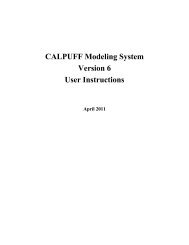Volume 1 - The Atmospheric Studies Group at TRC
Volume 1 - The Atmospheric Studies Group at TRC
Volume 1 - The Atmospheric Studies Group at TRC
You also want an ePaper? Increase the reach of your titles
YUMPU automatically turns print PDFs into web optimized ePapers that Google loves.
3.2 CALPUFF<br />
Pl<strong>at</strong>form Downwash<br />
<strong>The</strong> existing CALPUFF Huber-Snyder/Schulman-Scire (HS/SS) downwash modules<br />
are used to model downwash effects due to elev<strong>at</strong>ed structures by using th<strong>at</strong> portion<br />
of the structure th<strong>at</strong> is “solid”. A pl<strong>at</strong>form height (z pl<strong>at</strong> ) is added to the list of<br />
variables th<strong>at</strong> describe the effective building dimensions <strong>The</strong> effective building<br />
width H w and building height H b are prepared for each of 36 wind directions (10-<br />
degree intervals) by neglecting the gap below z pl<strong>at</strong> . Th<strong>at</strong> is, the structure is defined as<br />
if the solid portion rests on the “ground”, and the EPA Building Profile Input<br />
Program (BPIP) can be used to develop the direction-specific effective height and<br />
width. Any point-source emission released on or near the structure is prescribed<br />
using the full release height h s above the “ground”, not the height above the pl<strong>at</strong>form<br />
deck.<br />
<strong>The</strong> full release elev<strong>at</strong>ion above ground is adjusted by subtracting the pl<strong>at</strong>form height<br />
prior to any tests th<strong>at</strong> define the downwash potential (e.g., the 2.5 building-height<br />
rule for GEP), and any downwash plume enhancements th<strong>at</strong> depends on the effective<br />
stack height. This adjusted stack height is not used as the physical release height in<br />
any other calcul<strong>at</strong>ions.<br />
<strong>The</strong> Huber-Snyder (Huber and Snyder, 1976; Huber, 1977) technique is used for<br />
h − z > H + T L<br />
(3-36)<br />
s<br />
pl<strong>at</strong><br />
b<br />
bd<br />
b<br />
where L b is the lesser of the effective building height and width, and T bd has a default<br />
value of 0.5. A neg<strong>at</strong>ive value of T bd indic<strong>at</strong>es the Huber-Snyder method is used for<br />
all stacks, and a value of 1.5 results in the Schulman-Scire (Scire and Schulman,<br />
1980; Schulman and Hanna, 1986) method always being used. If T Tb is set equal to<br />
0.5 (its default value), the CALPUFF tre<strong>at</strong>ment will be equivalent to th<strong>at</strong> in ISC3.<br />
When the Huber-Snyder technique is used, the first step is to compute the effective<br />
plume height H e due to momentum rise <strong>at</strong> a downwind distance of 2 H b . This rise<br />
uses the wind speed <strong>at</strong> the full stack height, h s . If (H e –z pl<strong>at</strong> ) exceeds H b + 1.5 L b ,<br />
building downwash effects are assumed to be negligible. Otherwise, buildinginduced<br />
enhancement of the plume dispersion coefficients is evalu<strong>at</strong>ed. For adjusted<br />
stack heights h s –z pl<strong>at</strong> less than 1.2H b , both σ y and σ z are enhanced. Only σ z is<br />
enhanced for adjusted stack heights above 1.2 H b (but below H b + 1.5 L b ).<br />
Enhancements to σ y and σ z are not functions of h s or h s -z pl<strong>at</strong> .<br />
When the Schulman-Scire technique is used, a linear decay factor is applied to the<br />
building-induced enhancement of the vertical dispersion coefficient, and plume rise is<br />
Final Report Vol.1 16







